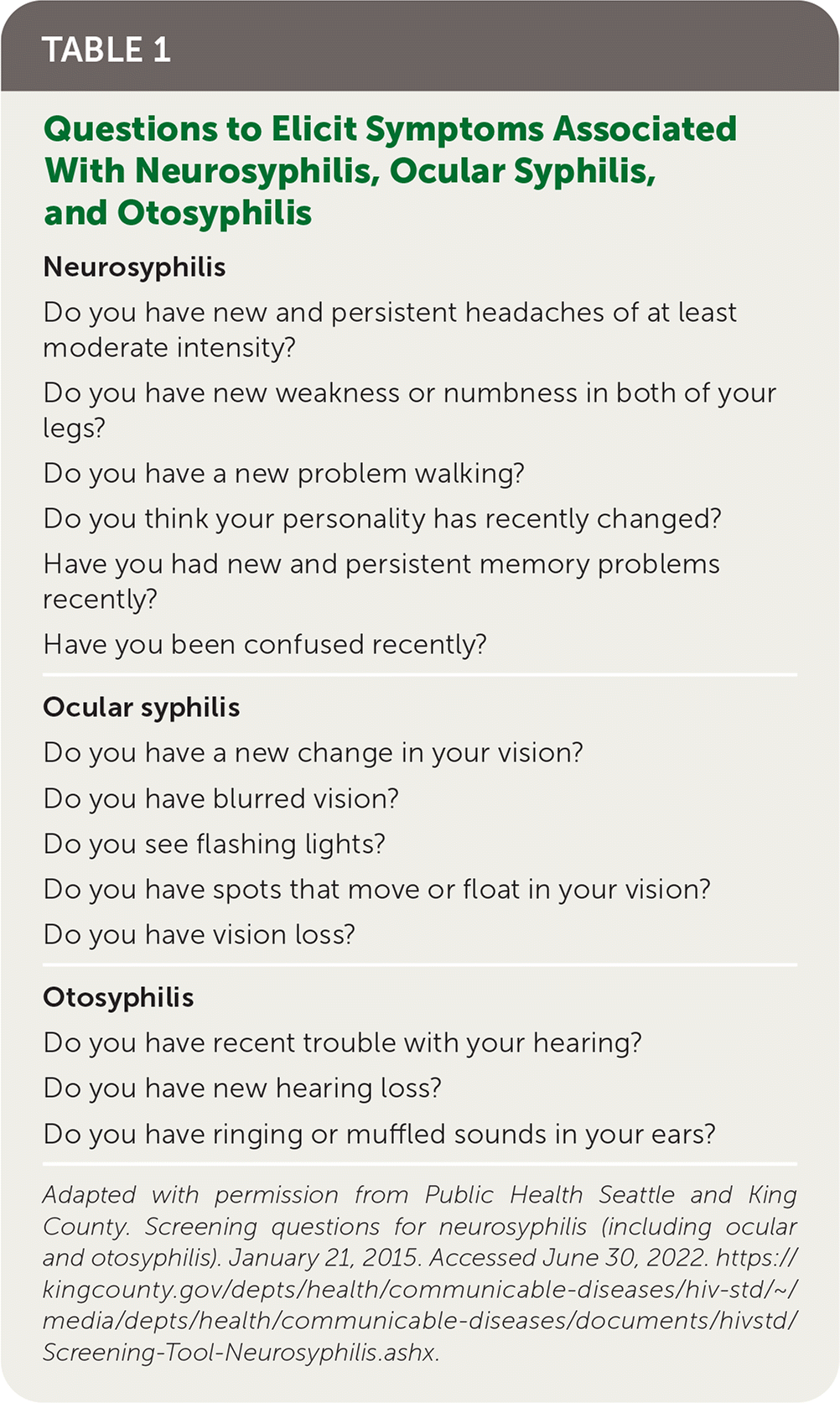
Am Fam Physician. 2022;106(2):122-123
Related article: Sexually Transmitted Infections: Updates From the 2021 CDC Guidelines
Author disclosure: No relevant financial relationships.
Syphilis rates in the United States are increasing rapidly.1 Treponema pallidum can infect the visual, auditory, and central nervous systems, leading to serious clinical consequences if not diagnosed and treated promptly. Family physicians may be the first to encounter patients presenting with signs and symptoms of syphilis and should be prepared to recognize the infection and offer treatment.
Neurosyphilis, ocular syphilis, and otosyphilis may occur at any stage of syphilis; however, these manifestations are more likely to occur in the early stages (i.e., primary, secondary, and early latent).2 These complicated syphilis infections can affect any patient, regardless of immune status. Patients with HIV infection, particularly those with low CD4 counts, are more likely to progress rapidly to neurosyphilis and ocular syphilis.2,3 A review of more than 500 syphilis cases in King County, Wash., showed that 3.5% of patients met the study criteria for confirmed symptomatic neurosyphilis or ocular syphilis.4 An Australian study suggests that 70% of patients thought to have probable neurosyphilis were not treated appropriately, based on the 2018 Centers for Disease Control and Prevention (CDC) criteria.5
The neurologic manifestations of syphilis may be divided into early and late neurosyphilis.6 Clinical presentations of early neurosyphilis occur within the first few years of untreated infection and may include headache, dizziness, altered mental status, cranial neuropathies, motor and sensory deficits, meningitis, or stroke.2,6,7 Late neurosyphilis is less common and staged as tertiary syphilis. It may occur years to decades after an untreated infection.2 Progressive cognitive dysfunction, sensory loss, gait impairment, and severe radicular pain may be associated with late neurosyphilis.2,6,7 A diagnosis of neurosyphilis requires a combination of neurologic signs and symptoms in addition to reactive syphilis serologic and cerebrospinal fluid (CSF) tests.7,8 Abnormal CSF findings can occur in patients with early syphilis and are of unknown significance in those without neurologic signs or symptoms.7 One systematic review discusses the challenges of diagnostic testing for neurosyphilis, including the absence of a universal diagnostic definition of neurosyphilis.9 The 2021 CDC Sexually Transmitted Infections Treatment Guidelines provide a diagnostic strategy for suspected neurosyphilis.2
Infections of the ocular or auditory systems can present with or without other neurologic involvement and may result in permanent vision and hearing loss.10,11 Uveitis is a common presentation of ocular syphilis, although other eye anatomy may be involved.2,10 Syphilis infection of the auditory system can present as sudden onset sensorineural hearing loss, vertigo, or tinnitus. Hearing loss may progress rapidly and affect one or both ears.2,11
Patients with ocular symptoms and reactive syphilis serology need an ophthalmologic examination that includes a cranial nerve evaluation and a slit lamp examination. If cranial nerve abnormalities are found, the patient should have a lumbar puncture to evaluate CSF.2,10 The CDC does not currently recommend a CSF examination for patients with reactive syphilis serology, isolated ocular symptoms and examination findings, and a normal neurologic examination. A CSF evaluation could be considered for patients with reactive syphilis serology and ocular symptoms but no ocular findings on examination.2 A CSF evaluation is not recommended for patients with reactive syphilis serology and isolated otologic findings.2 Patients thought to have ocular syphilis or otosyphilis should be referred for immediate comanagement with appropriate specialists.
The CDC recommends treating adults with neurosyphilis, ocular syphilis, or otosyphilis with aqueous crystalline penicillin G, 18 million to 24 million units per day, administered as 3 million to 4 million units intravenously every four hours or by continuous infusion for 10 to 14 days.2 For patients thought to have late, latent, or tertiary syphilis, additional antibiotic treatment is recommended.2 Detailed information about monitoring for serologic evidence of successful treatment in patients who are immunocompetent and immunosuppressed and indications for repeat CSF examinations are available in the 2021 CDC Sexually Transmitted Infections Treatment Guidelines.2 All patients with syphilis should also be tested for HIV infection. All syphilis infections must be reported to the local public health authority.
Family physicians should be aware of the presentations of syphilis infection. History (including sexual history), physical findings, and laboratory results help establish a diagnosis of complicated syphilis. There is no validated screening tool for neurosyphilis, but a checklist can aid in identifying symptoms that may be associated with neurosyphilis, ocular syphilis, and otosyphilis (Table 1).12 A multispecialty approach to care for patients with complicated syphilis promotes optimal clinical outcomes.

| Neurosyphilis |
| Do you have new and persistent headaches of at least moderate intensity? |
| Do you have new weakness or numbness in both of your legs? |
| Do you have a new problem walking? |
| Do you think your personality has recently changed? |
| Have you had new and persistent memory problems recently? |
| Have you been confused recently? |
| Ocular syphilis |
| Do you have a new change in your vision? |
| Do you have blurred vision? |
| Do you see flashing lights? |
| Do you have spots that move or float in your vision? |
| Do you have vision loss? |
| Otosyphilis |
| Do you have recent trouble with your hearing? |
| Do you have new hearing loss? |
| Do you have ringing or muffled sounds in your ears? |
